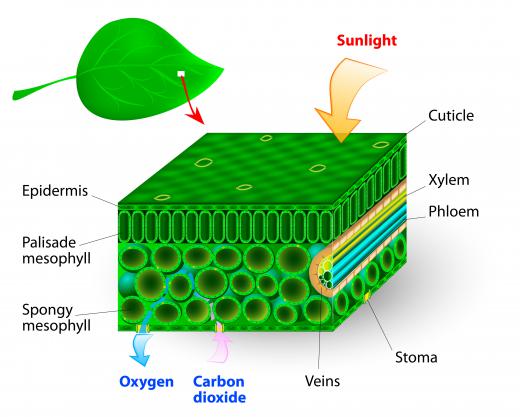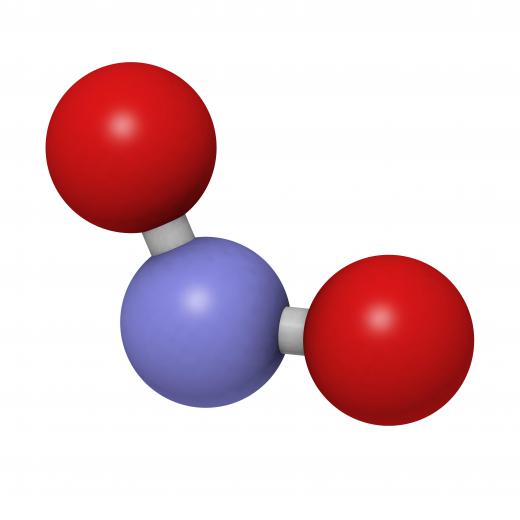What are the Different Examples of Chemical Energy?
Chemical energy is stored and released by the making and breaking of bonds between atoms. It is typically released when bonds are formed, and it is required to break them. Sometimes, however, compounds can be formed that store energy and release it later by undergoing chemical reactions, or rearranging themselves into molecules that, together, have less energy. These compounds can be created by natural processes, and by man. It is also possible to produce electricity chemically. There are many examples of chemical energy in action, both natural and man-made, including photosynthesis, respiration, combustion, explosives and batteries.
Chemical Reactions

A chemical reaction will take place when the atoms involved can reach a lower energy state by rearranging themselves in a different way. For example, two hydrogen molecules can combine with one of oxygen to produce two water molecules. Some energy — such as a naked flame or spark — is required to break the bonds within the existing molecules, but much more is released by the formation of the new bonds. The hydrogen and oxygen molecules can be regarded as storing energy that can be released under the right circumstances. The opposite reaction, splitting water into hydrogen and oxygen, takes a great deal of energy, which is why water is very stable.
Photosynthesis

Under the right circumstances, it is possible to create molecules that can store a lot of energy, but this must first be supplied from somewhere. One of the best examples of chemical energy storage is photosynthesis by green plants. In this case, sunlight provides the power to combine carbon dioxide from the atmosphere with water to produce sugar molecules, which the plant uses as food. Since sugar has more energy than carbon dioxide and water, they cannot combine directly. Photosynthesis, however, is a complex process that creates the sugar indirectly in a series of steps, using the power of the Sun.
Respiration

Cellular respiration can be viewed as the opposite of photosynthesis. When a person or other animal eats plant material, the sugar molecules are broken down, producing carbon dioxide and water. Since these, together, have less energy than the sugar, some is released. This is stored in a molecule called adenosine triphosphate (ATP) by adding a phosphate group to another molecule called adenosine diphosphate (ADP). It can be released again, when required, by the removal of this phosphate group; although some energy is required to do this, much more is released by the new bonds that the unattached phosphate group forms.
Combustion and Fuels

One of the most familiar examples of chemical energy is combustion. This is usually a reaction in which carbon and hydrogen in organic substances, such as wood or oil, combine with oxygen in the air to produce carbon dioxide, water, light and heat. It can also involve other elements, however. Combustion drives the motor car, powers the majority of electricity generating stations, and provides heat and cooking facilities for many homes.
The fuels used for combustion processes can be regarded as chemical stores of energy, much of which has ultimately come from the Sun. Coal, oil and natural gas come from the remains of ancient plants and animals that got their energy from photosynthesis or by eating plants that did so. These organic materials became buried in mud and silt, eventually forming the deposits that are exploited today.
Explosives
These substances are also energy stores. Their molecules consist of atoms that can rearrange themselves into other molecules that have far less energy, and when this happens, the difference is released as light and heat. Modern explosives are typically nitrated organic compounds, which means that they are carbon-hydrogen compounds that have had nitrogen-oxygen groups added to them. This is usually a relatively unstable formation: with quite a small stimulus, the existing bonds will break, and the atoms will regroup into molecules with much lower energy, such as carbon dioxide, water and nitrogen. The light and heat released, combined with the extremely fast transformation of a solid or liquid into gases, produces a violent explosion.
Batteries: Electricity from Chemicals
Chemical reactions can also be used to produce electricity. Atoms of some elements can easily give out electrons, while others like to gain electrons. Batteries exploit this fact by arranging two different elements or compounds in such a way that electrons can flow from one to the other when they are connected in a circuit, forming an electric current. A wide variety of different substances can be used to convert chemical energy to electricity in this way, and so there are many different types of battery that can be used to power phones, small computers, and electric circuitry in cars, among other things.
AS FEATURED ON:
AS FEATURED ON:














Discussion Comments
@pastanaga - Wind turbines aren't perfect though. They aren't welcome in many areas because of the noise pollution they generate and they take up a lot of space.
I think that some of our energy is going to come from a compromise between types of renewable energy and current non-renewable energy sources. For example, biofuel is used in basically the same way as petrol, but is made from plant and animal products and so it's a renewable chemical energy source. Not ideal, maybe, but at least it's an option.
@BabyBoomer67 - Well, that's true of any new energy type. The good thing about wind turbines is that they don't require a finite resource in order to produce energy. No matter how long you think the fossil fuels will last, everyone has to admit they must be finite.
But the wind is infinite.
Wind turbines do use chemical energy in one way though. They generally charge banks of batteries, which, as it says in the article, store energy with chemicals. They are one of the many renewable sources of energy which should be exploited as much as possible.
greenrings- Exactly how do these wind turbines work and are they a good substitution? I’ve heard investing in their stock is looking good and also wanting to learn more about wind energy.
But I also read that due to our economic status that the turbine production could stall and bring the values down sharply. I am concerned from both an economical and financial standpoint.
I read that China surpassed the United States for how much money we invested in wind energy in 2009, but we still have the greatest number of turbines in the world. I know we are heavily dependent on fossil fuels for our main source of energy, and therefore depend on other nations to supply our growing demand. But I really hope we can find renewable energy and become self dependent in the near future.
People need plants and trees to live more than they realize. I asked my teacher why the polar ice caps are melting and she told me to look it up online with my parents. I learned about global meltdown and how we need plants and trees in forests to turn the carbon dioxide we make into oxygen, so we can breathe. That’s why people protest to save the rain forests.
this website or article is the best. my teachers question me and my answers are correct so the teachers said to me very good erick and my classmates ask me what site do you visit to answer like that? i answer wisegeek.com
Post your comments